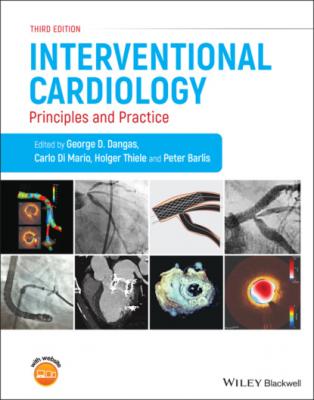Interventional Cardiology. Группа авторов
Читать онлайн.| Название | Interventional Cardiology |
|---|---|
| Автор произведения | Группа авторов |
| Жанр | Медицина |
| Серия | |
| Издательство | Медицина |
| Год выпуска | 0 |
| isbn | 9781119697381 |
Figure 9.8 Angiography at baseline without significant stenosis (a). Angiography at one year follow‐up with a stenotic lesion at the region of MaxLCBI4mm from baseline assessment (b). Chemogram (c) from baseline near‐infrared spectroscopy (NIRS) with MaxLCBI4mm = 472 at the site of a future event at one year post index procedure.
The recent IBIS‐3 trial demonstrated that high‐intensity rosuvastatin therapy during one year resulted in a neutral effect on NC and LCBI within non‐stenotic, non‐culprit coronary segments with a relatively low atheroma burden (The Netherlands Trial Register n. 2872).
Prevention of peri‐procedural myocardial infarction and optimizing interventions
Peri‐procedural myocardial infarction can be related to distal embolization of LCP component, contents, and/or intracoronary thrombus. In a sub‐study of COLOR (Chemometric Observation of Lipid Core Plaques of Interest in Native Coronary Arteries) registry, the cardiac biomarkers in 62 stable patients undergoing stenting were evaluated. Findings revealed that 7 out of 14 (50%) patients with a maxLCBI4mm ≥500 developed peri‐procedural myocardial infarction in comparison with the occurrence of this in only 2 out of 48 (4.2%) patients with a < maxLCBI4mm [129]. In a study by Raghunathan et al. [130], in which a creatinine kinase‐MB increase >3 times the upper normal limit was observed in 27% of patients with a ≥1 yellow block as opposed to none of the patients without a yellow block within the stented lesion. Similarly, in the CANARY (Coronary Assessment by Near‐infrared of Atherosclerotic Rupture‐prone Yellow) trial, patients with periinterventional myocardial infarction had higher maxLCBI4mm than patients without MI [131]. However, preventive measures for this situation remain uncertain. The use of a distal emboli protection device frequently resulted in embolized material retrieval during intervention in a small group of patients with LCP [132]; however, there was no benefit of this adjunctive treatment in the randomized CANARY trial.
A prospective use of NIRS in catheterization laboratories is in stent sizing to ensure adequate lesion coverage. Visual evaluation of lesions by angiography occasionally lack accuracy and using NIRS, Dixon et al. [133] demonstrated that in 16% of the lesions assessed in their study, the LCP extended beyond the angiographic margins of the initial target lesion. Therefore, together with the information provided by IVUS, NIRS data can be used for determining the size and length of the artery to be stented.
Guiding the effects of treatment
The effects of current or novel agents that modify plaque composition can be evaluated using NIRS, because it is able to assess the lipid content over time. The YELLOW trial recruited patients with multivessel CAD undergoing PCI. After NIRS and IVUS baseline assessment, patients were randomized to either rosuvastatin 40 mg/day vs the standard of care lipid‐lowering therapy. After seven weeks of short‐term intensive statin therapy, a significant reduction in the lipid content was found when measured via max LCBI4mm [134].
Ongoing trial
The prospective multicenter PROSPECT II trial aims to collect the post‐PCI NIRS/IVUS data of patients with ACS and evaluate the prognostic value of LCBI >400 to evaluate in the two year follow‐up.
Near‐infrared fluorescence molecular imaging
Current intravascular imaging approaches such as OCT or IVUS are inable to assess specific biologic processes in the coronary arteries in vivo. Molecular imaging is a relatively new field that aims to image specific molecules and cells involved in the pathogenesis of vascular disease, including macrophages, endothelial cell adhesion molecules, fibrin, and coagulation factor XIII activity [136,137]. Molecular imaging requires injectable targeted imaging agents that bind a specific molecular or internalized within a cell. These agents can then be detected by an appropriate hardware imaging system, including positron‐emission tomography (PET), magnetic resonance imaging (MRI), single‐photon emission tomography (SPECT), ultrasound and, more recently, fluorescence imaging systems.
While PET and MRI molecular imaging approaches appear promising for large arterial beds (e.g. carotids, peripheral arteries), the smaller size of the coronary arteries dictates an intravascular‐based imaging approach to achieve sufficient sensitivity and resolution. To meet this need, optical‐based imaging using near‐infrared fluorescence (NIRF) has evolved to serve as a promising coronary artery‐targeted intravascular imaging platform. The NIR window (650–900 nm) is advantageous for fluorescence imaging as this window exhibits reduced blood absorption and scattering, and reduced background tissue autofluorescence, which serves to increase the ability to detect NIRF molecular imaging agents in vivo.
In the last decade, several intravascular NIRF systems have been engineered, including a one‐dimensional wire spectroscopic‐based system, a standalone two‐dimensional imaging system, and most recently, a combined NIRF‐OCT imaging system [138,139].(Figure 9.9). Several preclinical investigations have provided the first clinical‐type demonstrations of imaging inflammatory protease activity and endothelial leakage in atheroma [138–142], fibrin deposition and inflammation on stents[143,144], and imaging the plaque response to paclitaxel drug‐coated balloons [145]. Imaging occurred in vivo in human coronary‐sized arteries of rabbits and pigs, suggesting the potential for clinical translation. The most recent NIRF‐OCT system has the further advantage of providing simultaneous anatomic information that is precisely co‐registered with NIRF molecular information, which further allows quantitative NIRF imaging (Figure 9.8). Similarly to NIRF‐OCT, a NIRF‐IVUS catheter has been developed and is undergoing clinical translation [146].
Figure 9.9 Intravascular near‐infrared fluorescence molecular imaging of plaque inflammation integrated with exactly co‐registered OCT. A dual‐modal near‐infrared fluorescence
